PPMP20011 - Project Negotiation, Conflict, and Stakeholder Report
VerifiedAdded on 2023/06/10
|7
|2467
|154
Report
AI Summary
This report analyzes project negotiation and conflict management within the context of the Queensland Health Payroll Program, drawing upon a generic negotiation model. It examines four projects: forward strategy for payroll system, governance and decision-making, people and change, and funding. The report identifies key participants, including owners, designers, and contractors, and explores negotiation interaction processes, such as strategic, structural, behavioral, and integrative approaches. Distributive and integrative negotiation methods are evaluated for each project, leading to outcomes focused on improving negotiation processes, healthcare service delivery, worker satisfaction, and financial management. The analysis references various sources and emphasizes the importance of stakeholder engagement and effective communication for successful project outcomes. Desklib offers more resources like this for students.
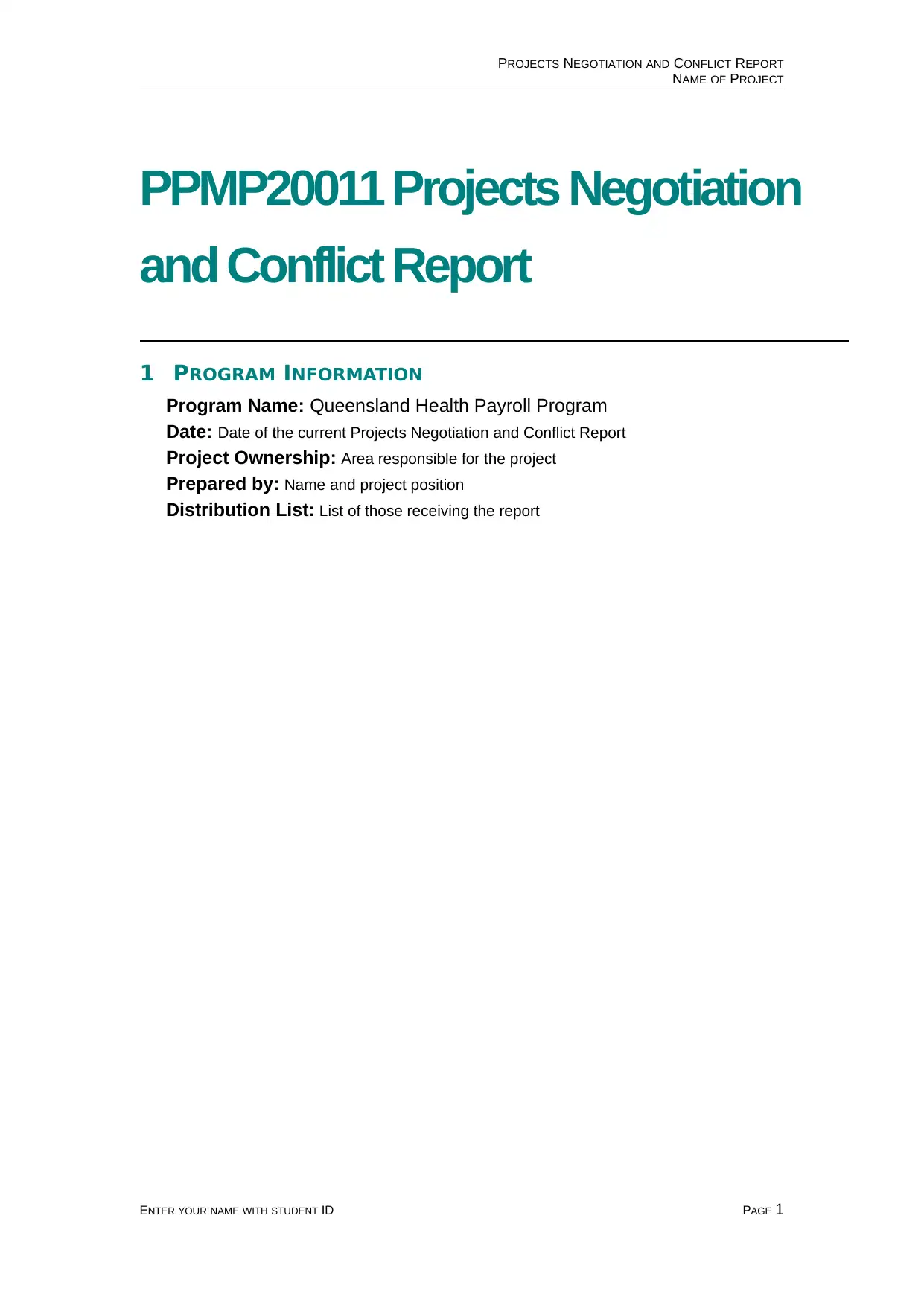
PROJECTS NEGOTIATION AND CONFLICT REPORT
NAME OF PROJECT
PPMP20011 Projects Negotiation
and Conflict Report
1 PROGRAM INFORMATION
Program Name: Queensland Health Payroll Program
Date: Date of the current Projects Negotiation and Conflict Report
Project Ownership: Area responsible for the project
Prepared by: Name and project position
Distribution List: List of those receiving the report
ENTER YOUR NAME WITH STUDENT ID PAGE 1
NAME OF PROJECT
PPMP20011 Projects Negotiation
and Conflict Report
1 PROGRAM INFORMATION
Program Name: Queensland Health Payroll Program
Date: Date of the current Projects Negotiation and Conflict Report
Project Ownership: Area responsible for the project
Prepared by: Name and project position
Distribution List: List of those receiving the report
ENTER YOUR NAME WITH STUDENT ID PAGE 1
Paraphrase This Document
Need a fresh take? Get an instant paraphrase of this document with our AI Paraphraser
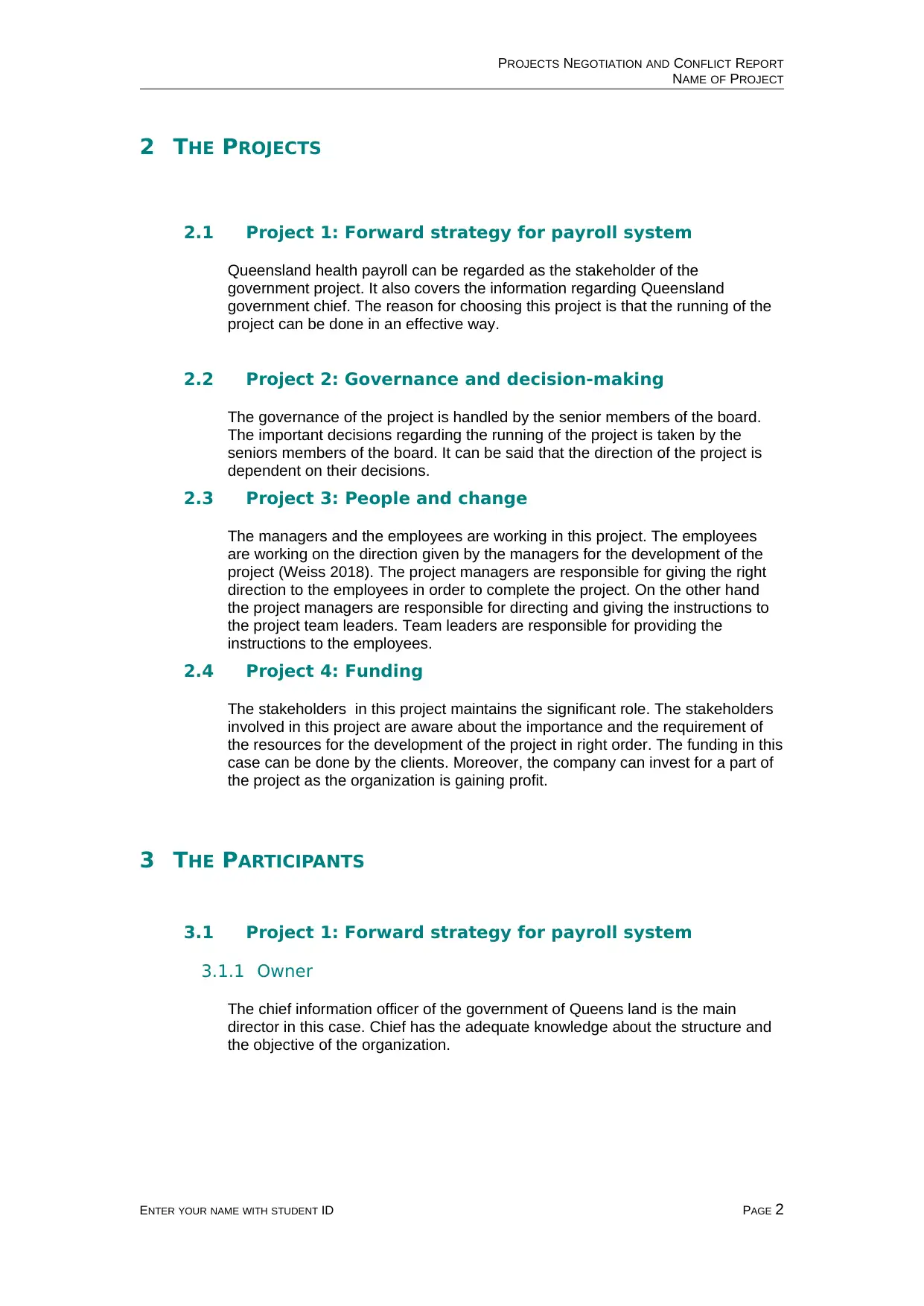
PROJECTS NEGOTIATION AND CONFLICT REPORT
NAME OF PROJECT
2 THE PROJECTS
2.1 Project 1: Forward strategy for payroll system
Queensland health payroll can be regarded as the stakeholder of the
government project. It also covers the information regarding Queensland
government chief. The reason for choosing this project is that the running of the
project can be done in an effective way.
2.2 Project 2: Governance and decision-making
The governance of the project is handled by the senior members of the board.
The important decisions regarding the running of the project is taken by the
seniors members of the board. It can be said that the direction of the project is
dependent on their decisions.
2.3 Project 3: People and change
The managers and the employees are working in this project. The employees
are working on the direction given by the managers for the development of the
project (Weiss 2018). The project managers are responsible for giving the right
direction to the employees in order to complete the project. On the other hand
the project managers are responsible for directing and giving the instructions to
the project team leaders. Team leaders are responsible for providing the
instructions to the employees.
2.4 Project 4: Funding
The stakeholders in this project maintains the significant role. The stakeholders
involved in this project are aware about the importance and the requirement of
the resources for the development of the project in right order. The funding in this
case can be done by the clients. Moreover, the company can invest for a part of
the project as the organization is gaining profit.
3 THE PARTICIPANTS
3.1 Project 1: Forward strategy for payroll system
3.1.1 Owner
The chief information officer of the government of Queens land is the main
director in this case. Chief has the adequate knowledge about the structure and
the objective of the organization.
ENTER YOUR NAME WITH STUDENT ID PAGE 2
NAME OF PROJECT
2 THE PROJECTS
2.1 Project 1: Forward strategy for payroll system
Queensland health payroll can be regarded as the stakeholder of the
government project. It also covers the information regarding Queensland
government chief. The reason for choosing this project is that the running of the
project can be done in an effective way.
2.2 Project 2: Governance and decision-making
The governance of the project is handled by the senior members of the board.
The important decisions regarding the running of the project is taken by the
seniors members of the board. It can be said that the direction of the project is
dependent on their decisions.
2.3 Project 3: People and change
The managers and the employees are working in this project. The employees
are working on the direction given by the managers for the development of the
project (Weiss 2018). The project managers are responsible for giving the right
direction to the employees in order to complete the project. On the other hand
the project managers are responsible for directing and giving the instructions to
the project team leaders. Team leaders are responsible for providing the
instructions to the employees.
2.4 Project 4: Funding
The stakeholders in this project maintains the significant role. The stakeholders
involved in this project are aware about the importance and the requirement of
the resources for the development of the project in right order. The funding in this
case can be done by the clients. Moreover, the company can invest for a part of
the project as the organization is gaining profit.
3 THE PARTICIPANTS
3.1 Project 1: Forward strategy for payroll system
3.1.1 Owner
The chief information officer of the government of Queens land is the main
director in this case. Chief has the adequate knowledge about the structure and
the objective of the organization.
ENTER YOUR NAME WITH STUDENT ID PAGE 2
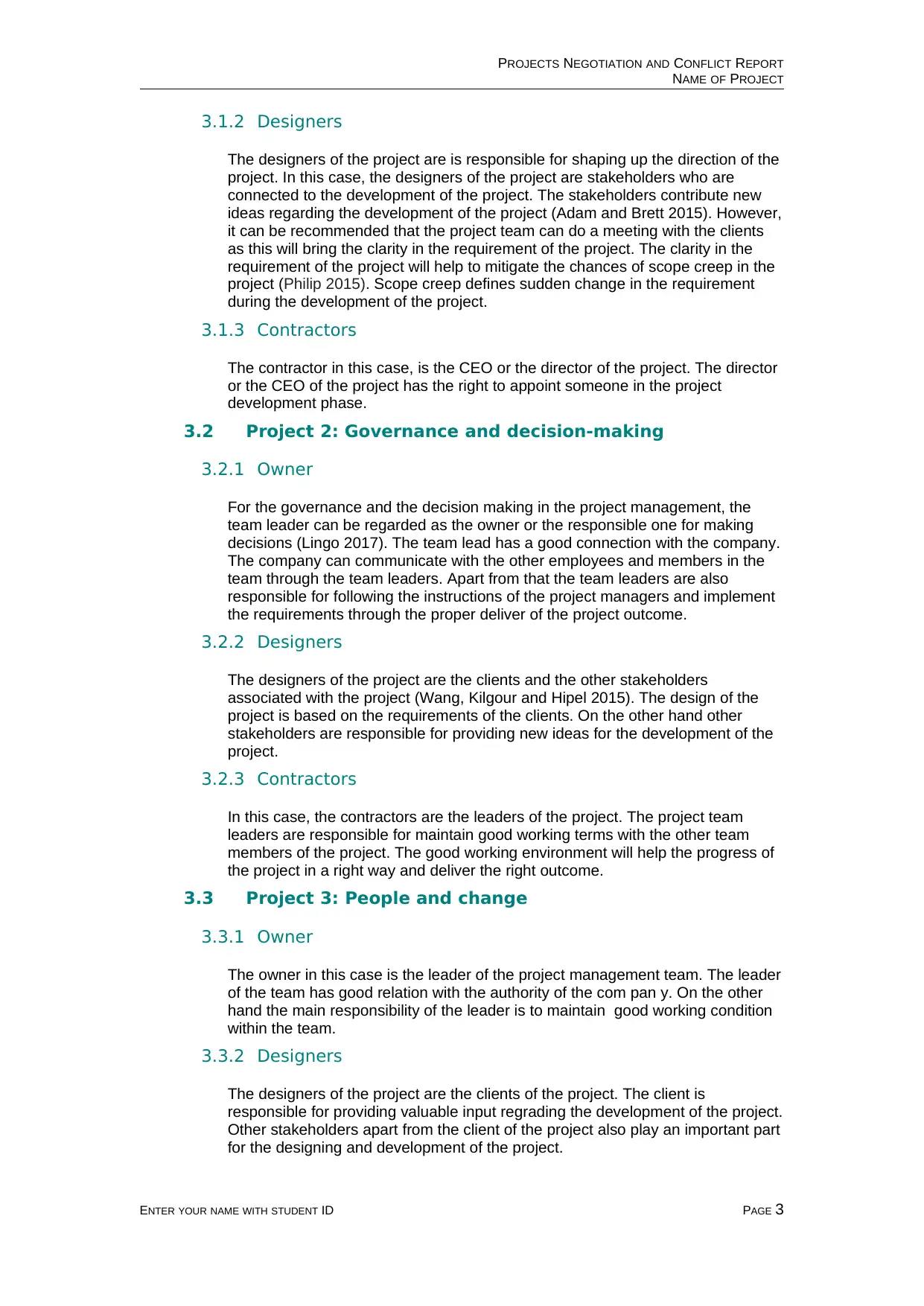
PROJECTS NEGOTIATION AND CONFLICT REPORT
NAME OF PROJECT
3.1.2 Designers
The designers of the project are is responsible for shaping up the direction of the
project. In this case, the designers of the project are stakeholders who are
connected to the development of the project. The stakeholders contribute new
ideas regarding the development of the project (Adam and Brett 2015). However,
it can be recommended that the project team can do a meeting with the clients
as this will bring the clarity in the requirement of the project. The clarity in the
requirement of the project will help to mitigate the chances of scope creep in the
project (Philip 2015). Scope creep defines sudden change in the requirement
during the development of the project.
3.1.3 Contractors
The contractor in this case, is the CEO or the director of the project. The director
or the CEO of the project has the right to appoint someone in the project
development phase.
3.2 Project 2: Governance and decision-making
3.2.1 Owner
For the governance and the decision making in the project management, the
team leader can be regarded as the owner or the responsible one for making
decisions (Lingo 2017). The team lead has a good connection with the company.
The company can communicate with the other employees and members in the
team through the team leaders. Apart from that the team leaders are also
responsible for following the instructions of the project managers and implement
the requirements through the proper deliver of the project outcome.
3.2.2 Designers
The designers of the project are the clients and the other stakeholders
associated with the project (Wang, Kilgour and Hipel 2015). The design of the
project is based on the requirements of the clients. On the other hand other
stakeholders are responsible for providing new ideas for the development of the
project.
3.2.3 Contractors
In this case, the contractors are the leaders of the project. The project team
leaders are responsible for maintain good working terms with the other team
members of the project. The good working environment will help the progress of
the project in a right way and deliver the right outcome.
3.3 Project 3: People and change
3.3.1 Owner
The owner in this case is the leader of the project management team. The leader
of the team has good relation with the authority of the com pan y. On the other
hand the main responsibility of the leader is to maintain good working condition
within the team.
3.3.2 Designers
The designers of the project are the clients of the project. The client is
responsible for providing valuable input regrading the development of the project.
Other stakeholders apart from the client of the project also play an important part
for the designing and development of the project.
ENTER YOUR NAME WITH STUDENT ID PAGE 3
NAME OF PROJECT
3.1.2 Designers
The designers of the project are is responsible for shaping up the direction of the
project. In this case, the designers of the project are stakeholders who are
connected to the development of the project. The stakeholders contribute new
ideas regarding the development of the project (Adam and Brett 2015). However,
it can be recommended that the project team can do a meeting with the clients
as this will bring the clarity in the requirement of the project. The clarity in the
requirement of the project will help to mitigate the chances of scope creep in the
project (Philip 2015). Scope creep defines sudden change in the requirement
during the development of the project.
3.1.3 Contractors
The contractor in this case, is the CEO or the director of the project. The director
or the CEO of the project has the right to appoint someone in the project
development phase.
3.2 Project 2: Governance and decision-making
3.2.1 Owner
For the governance and the decision making in the project management, the
team leader can be regarded as the owner or the responsible one for making
decisions (Lingo 2017). The team lead has a good connection with the company.
The company can communicate with the other employees and members in the
team through the team leaders. Apart from that the team leaders are also
responsible for following the instructions of the project managers and implement
the requirements through the proper deliver of the project outcome.
3.2.2 Designers
The designers of the project are the clients and the other stakeholders
associated with the project (Wang, Kilgour and Hipel 2015). The design of the
project is based on the requirements of the clients. On the other hand other
stakeholders are responsible for providing new ideas for the development of the
project.
3.2.3 Contractors
In this case, the contractors are the leaders of the project. The project team
leaders are responsible for maintain good working terms with the other team
members of the project. The good working environment will help the progress of
the project in a right way and deliver the right outcome.
3.3 Project 3: People and change
3.3.1 Owner
The owner in this case is the leader of the project management team. The leader
of the team has good relation with the authority of the com pan y. On the other
hand the main responsibility of the leader is to maintain good working condition
within the team.
3.3.2 Designers
The designers of the project are the clients of the project. The client is
responsible for providing valuable input regrading the development of the project.
Other stakeholders apart from the client of the project also play an important part
for the designing and development of the project.
ENTER YOUR NAME WITH STUDENT ID PAGE 3
⊘ This is a preview!⊘
Do you want full access?
Subscribe today to unlock all pages.

Trusted by 1+ million students worldwide
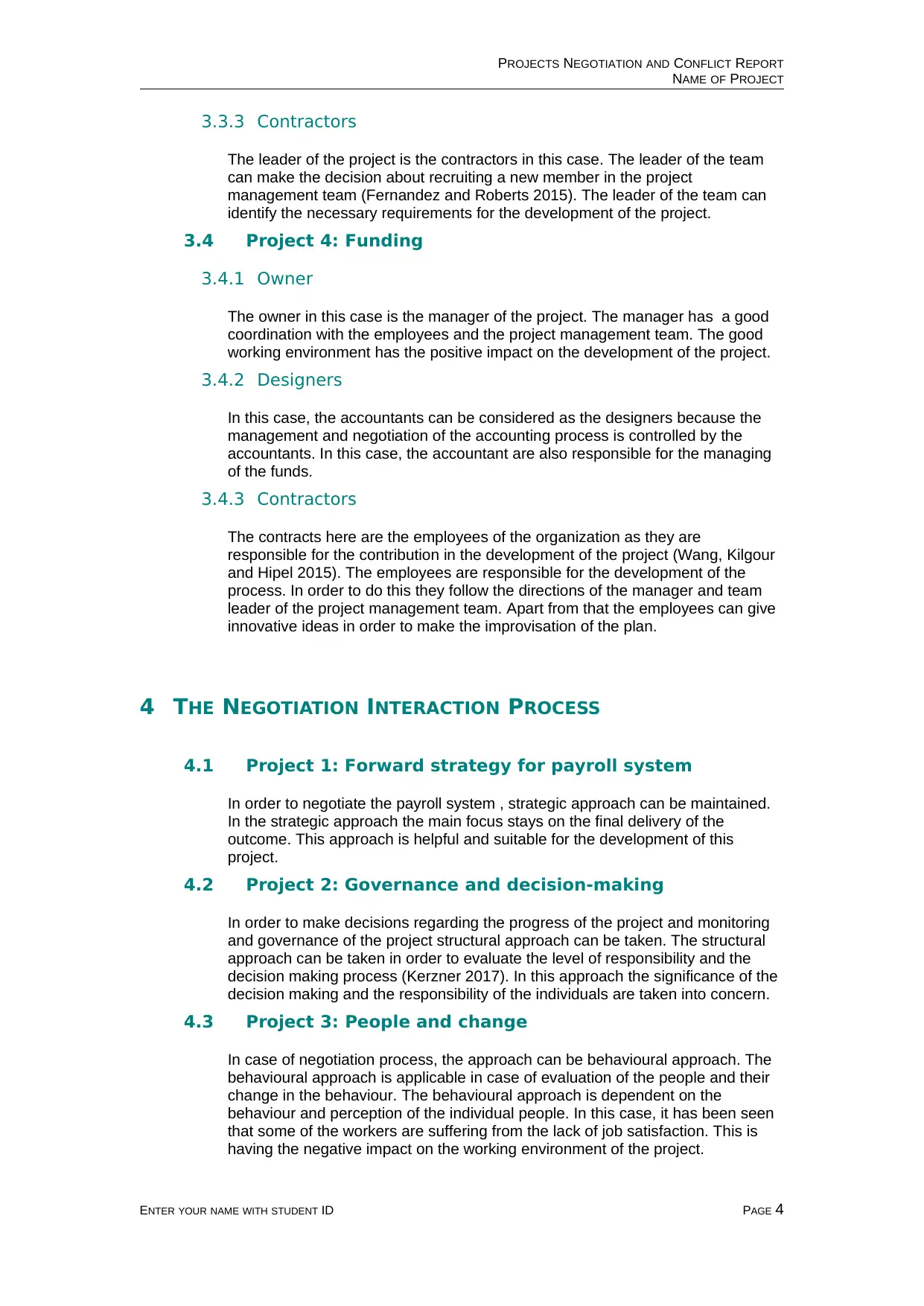
PROJECTS NEGOTIATION AND CONFLICT REPORT
NAME OF PROJECT
3.3.3 Contractors
The leader of the project is the contractors in this case. The leader of the team
can make the decision about recruiting a new member in the project
management team (Fernandez and Roberts 2015). The leader of the team can
identify the necessary requirements for the development of the project.
3.4 Project 4: Funding
3.4.1 Owner
The owner in this case is the manager of the project. The manager has a good
coordination with the employees and the project management team. The good
working environment has the positive impact on the development of the project.
3.4.2 Designers
In this case, the accountants can be considered as the designers because the
management and negotiation of the accounting process is controlled by the
accountants. In this case, the accountant are also responsible for the managing
of the funds.
3.4.3 Contractors
The contracts here are the employees of the organization as they are
responsible for the contribution in the development of the project (Wang, Kilgour
and Hipel 2015). The employees are responsible for the development of the
process. In order to do this they follow the directions of the manager and team
leader of the project management team. Apart from that the employees can give
innovative ideas in order to make the improvisation of the plan.
4 THE NEGOTIATION INTERACTION PROCESS
4.1 Project 1: Forward strategy for payroll system
In order to negotiate the payroll system , strategic approach can be maintained.
In the strategic approach the main focus stays on the final delivery of the
outcome. This approach is helpful and suitable for the development of this
project.
4.2 Project 2: Governance and decision-making
In order to make decisions regarding the progress of the project and monitoring
and governance of the project structural approach can be taken. The structural
approach can be taken in order to evaluate the level of responsibility and the
decision making process (Kerzner 2017). In this approach the significance of the
decision making and the responsibility of the individuals are taken into concern.
4.3 Project 3: People and change
In case of negotiation process, the approach can be behavioural approach. The
behavioural approach is applicable in case of evaluation of the people and their
change in the behaviour. The behavioural approach is dependent on the
behaviour and perception of the individual people. In this case, it has been seen
that some of the workers are suffering from the lack of job satisfaction. This is
having the negative impact on the working environment of the project.
ENTER YOUR NAME WITH STUDENT ID PAGE 4
NAME OF PROJECT
3.3.3 Contractors
The leader of the project is the contractors in this case. The leader of the team
can make the decision about recruiting a new member in the project
management team (Fernandez and Roberts 2015). The leader of the team can
identify the necessary requirements for the development of the project.
3.4 Project 4: Funding
3.4.1 Owner
The owner in this case is the manager of the project. The manager has a good
coordination with the employees and the project management team. The good
working environment has the positive impact on the development of the project.
3.4.2 Designers
In this case, the accountants can be considered as the designers because the
management and negotiation of the accounting process is controlled by the
accountants. In this case, the accountant are also responsible for the managing
of the funds.
3.4.3 Contractors
The contracts here are the employees of the organization as they are
responsible for the contribution in the development of the project (Wang, Kilgour
and Hipel 2015). The employees are responsible for the development of the
process. In order to do this they follow the directions of the manager and team
leader of the project management team. Apart from that the employees can give
innovative ideas in order to make the improvisation of the plan.
4 THE NEGOTIATION INTERACTION PROCESS
4.1 Project 1: Forward strategy for payroll system
In order to negotiate the payroll system , strategic approach can be maintained.
In the strategic approach the main focus stays on the final delivery of the
outcome. This approach is helpful and suitable for the development of this
project.
4.2 Project 2: Governance and decision-making
In order to make decisions regarding the progress of the project and monitoring
and governance of the project structural approach can be taken. The structural
approach can be taken in order to evaluate the level of responsibility and the
decision making process (Kerzner 2017). In this approach the significance of the
decision making and the responsibility of the individuals are taken into concern.
4.3 Project 3: People and change
In case of negotiation process, the approach can be behavioural approach. The
behavioural approach is applicable in case of evaluation of the people and their
change in the behaviour. The behavioural approach is dependent on the
behaviour and perception of the individual people. In this case, it has been seen
that some of the workers are suffering from the lack of job satisfaction. This is
having the negative impact on the working environment of the project.
ENTER YOUR NAME WITH STUDENT ID PAGE 4
Paraphrase This Document
Need a fresh take? Get an instant paraphrase of this document with our AI Paraphraser
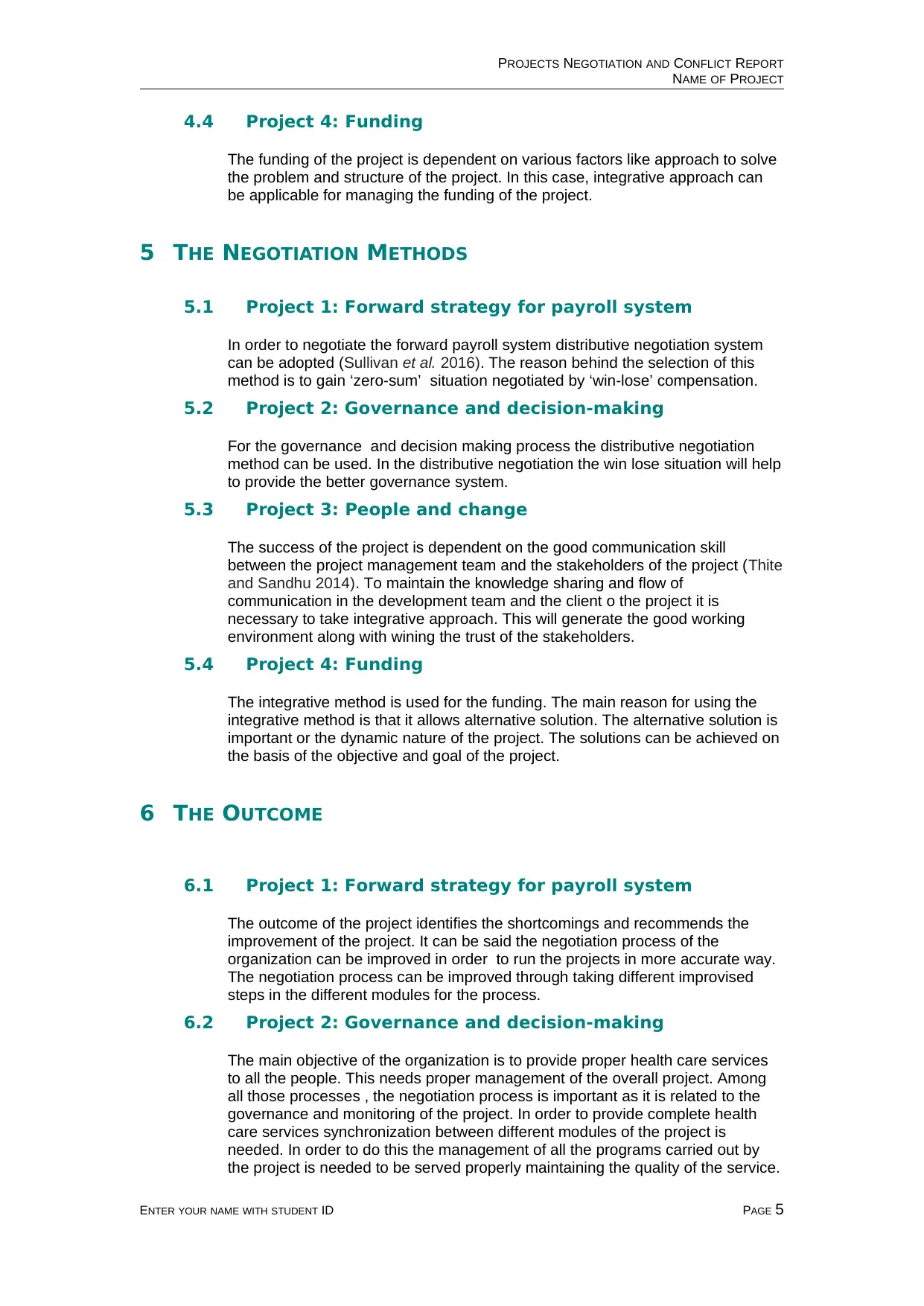
PROJECTS NEGOTIATION AND CONFLICT REPORT
NAME OF PROJECT
4.4 Project 4: Funding
The funding of the project is dependent on various factors like approach to solve
the problem and structure of the project. In this case, integrative approach can
be applicable for managing the funding of the project.
5 THE NEGOTIATION METHODS
5.1 Project 1: Forward strategy for payroll system
In order to negotiate the forward payroll system distributive negotiation system
can be adopted (Sullivan et al. 2016). The reason behind the selection of this
method is to gain ‘zero-sum’ situation negotiated by ‘win-lose’ compensation.
5.2 Project 2: Governance and decision-making
For the governance and decision making process the distributive negotiation
method can be used. In the distributive negotiation the win lose situation will help
to provide the better governance system.
5.3 Project 3: People and change
The success of the project is dependent on the good communication skill
between the project management team and the stakeholders of the project (Thite
and Sandhu 2014). To maintain the knowledge sharing and flow of
communication in the development team and the client o the project it is
necessary to take integrative approach. This will generate the good working
environment along with wining the trust of the stakeholders.
5.4 Project 4: Funding
The integrative method is used for the funding. The main reason for using the
integrative method is that it allows alternative solution. The alternative solution is
important or the dynamic nature of the project. The solutions can be achieved on
the basis of the objective and goal of the project.
6 THE OUTCOME
6.1 Project 1: Forward strategy for payroll system
The outcome of the project identifies the shortcomings and recommends the
improvement of the project. It can be said the negotiation process of the
organization can be improved in order to run the projects in more accurate way.
The negotiation process can be improved through taking different improvised
steps in the different modules for the process.
6.2 Project 2: Governance and decision-making
The main objective of the organization is to provide proper health care services
to all the people. This needs proper management of the overall project. Among
all those processes , the negotiation process is important as it is related to the
governance and monitoring of the project. In order to provide complete health
care services synchronization between different modules of the project is
needed. In order to do this the management of all the programs carried out by
the project is needed to be served properly maintaining the quality of the service.
ENTER YOUR NAME WITH STUDENT ID PAGE 5
NAME OF PROJECT
4.4 Project 4: Funding
The funding of the project is dependent on various factors like approach to solve
the problem and structure of the project. In this case, integrative approach can
be applicable for managing the funding of the project.
5 THE NEGOTIATION METHODS
5.1 Project 1: Forward strategy for payroll system
In order to negotiate the forward payroll system distributive negotiation system
can be adopted (Sullivan et al. 2016). The reason behind the selection of this
method is to gain ‘zero-sum’ situation negotiated by ‘win-lose’ compensation.
5.2 Project 2: Governance and decision-making
For the governance and decision making process the distributive negotiation
method can be used. In the distributive negotiation the win lose situation will help
to provide the better governance system.
5.3 Project 3: People and change
The success of the project is dependent on the good communication skill
between the project management team and the stakeholders of the project (Thite
and Sandhu 2014). To maintain the knowledge sharing and flow of
communication in the development team and the client o the project it is
necessary to take integrative approach. This will generate the good working
environment along with wining the trust of the stakeholders.
5.4 Project 4: Funding
The integrative method is used for the funding. The main reason for using the
integrative method is that it allows alternative solution. The alternative solution is
important or the dynamic nature of the project. The solutions can be achieved on
the basis of the objective and goal of the project.
6 THE OUTCOME
6.1 Project 1: Forward strategy for payroll system
The outcome of the project identifies the shortcomings and recommends the
improvement of the project. It can be said the negotiation process of the
organization can be improved in order to run the projects in more accurate way.
The negotiation process can be improved through taking different improvised
steps in the different modules for the process.
6.2 Project 2: Governance and decision-making
The main objective of the organization is to provide proper health care services
to all the people. This needs proper management of the overall project. Among
all those processes , the negotiation process is important as it is related to the
governance and monitoring of the project. In order to provide complete health
care services synchronization between different modules of the project is
needed. In order to do this the management of all the programs carried out by
the project is needed to be served properly maintaining the quality of the service.
ENTER YOUR NAME WITH STUDENT ID PAGE 5
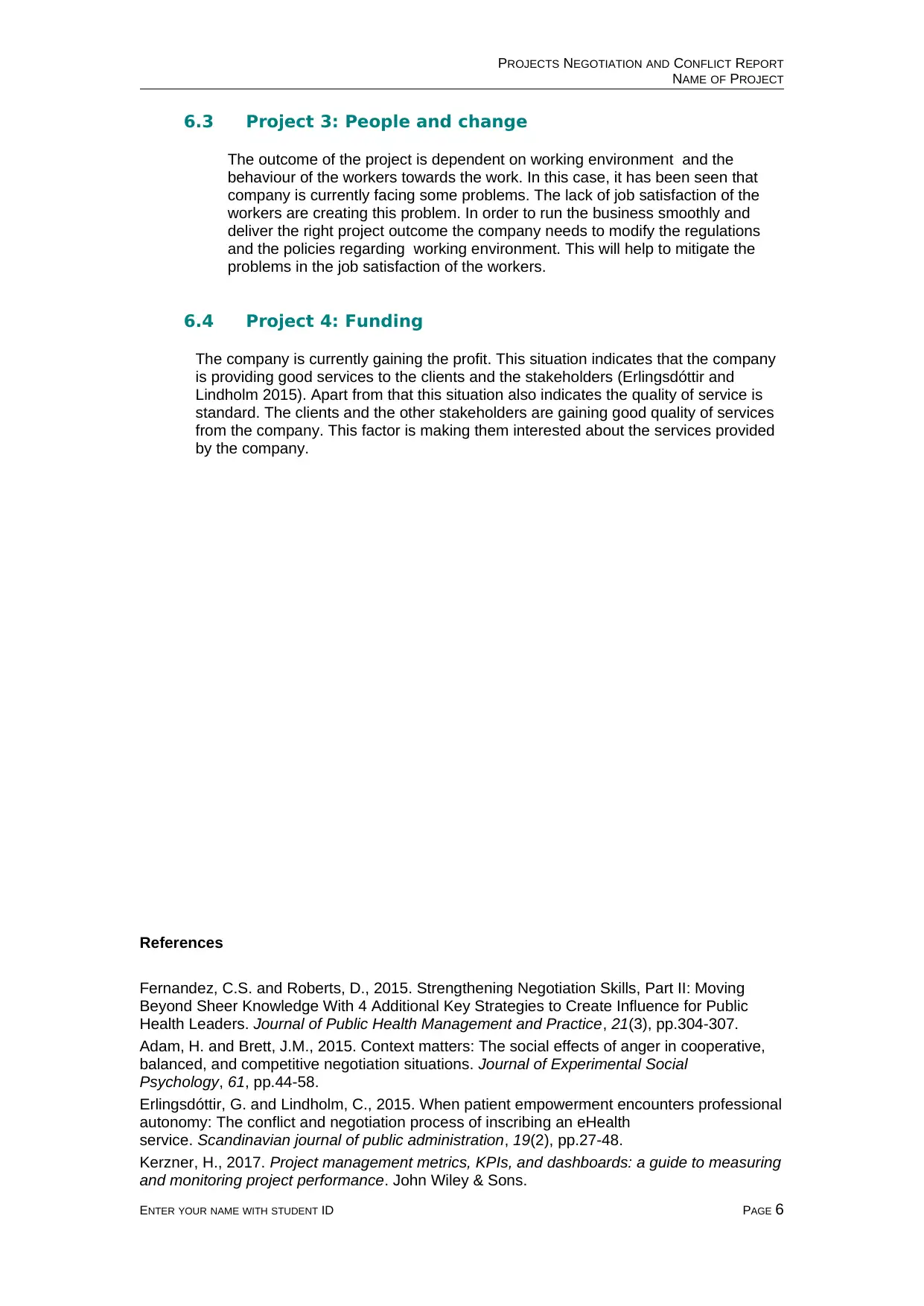
PROJECTS NEGOTIATION AND CONFLICT REPORT
NAME OF PROJECT
6.3 Project 3: People and change
The outcome of the project is dependent on working environment and the
behaviour of the workers towards the work. In this case, it has been seen that
company is currently facing some problems. The lack of job satisfaction of the
workers are creating this problem. In order to run the business smoothly and
deliver the right project outcome the company needs to modify the regulations
and the policies regarding working environment. This will help to mitigate the
problems in the job satisfaction of the workers.
6.4 Project 4: Funding
The company is currently gaining the profit. This situation indicates that the company
is providing good services to the clients and the stakeholders (Erlingsdóttir and
Lindholm 2015). Apart from that this situation also indicates the quality of service is
standard. The clients and the other stakeholders are gaining good quality of services
from the company. This factor is making them interested about the services provided
by the company.
References
Fernandez, C.S. and Roberts, D., 2015. Strengthening Negotiation Skills, Part II: Moving
Beyond Sheer Knowledge With 4 Additional Key Strategies to Create Influence for Public
Health Leaders. Journal of Public Health Management and Practice, 21(3), pp.304-307.
Adam, H. and Brett, J.M., 2015. Context matters: The social effects of anger in cooperative,
balanced, and competitive negotiation situations. Journal of Experimental Social
Psychology, 61, pp.44-58.
Erlingsdóttir, G. and Lindholm, C., 2015. When patient empowerment encounters professional
autonomy: The conflict and negotiation process of inscribing an eHealth
service. Scandinavian journal of public administration, 19(2), pp.27-48.
Kerzner, H., 2017. Project management metrics, KPIs, and dashboards: a guide to measuring
and monitoring project performance. John Wiley & Sons.
ENTER YOUR NAME WITH STUDENT ID PAGE 6
NAME OF PROJECT
6.3 Project 3: People and change
The outcome of the project is dependent on working environment and the
behaviour of the workers towards the work. In this case, it has been seen that
company is currently facing some problems. The lack of job satisfaction of the
workers are creating this problem. In order to run the business smoothly and
deliver the right project outcome the company needs to modify the regulations
and the policies regarding working environment. This will help to mitigate the
problems in the job satisfaction of the workers.
6.4 Project 4: Funding
The company is currently gaining the profit. This situation indicates that the company
is providing good services to the clients and the stakeholders (Erlingsdóttir and
Lindholm 2015). Apart from that this situation also indicates the quality of service is
standard. The clients and the other stakeholders are gaining good quality of services
from the company. This factor is making them interested about the services provided
by the company.
References
Fernandez, C.S. and Roberts, D., 2015. Strengthening Negotiation Skills, Part II: Moving
Beyond Sheer Knowledge With 4 Additional Key Strategies to Create Influence for Public
Health Leaders. Journal of Public Health Management and Practice, 21(3), pp.304-307.
Adam, H. and Brett, J.M., 2015. Context matters: The social effects of anger in cooperative,
balanced, and competitive negotiation situations. Journal of Experimental Social
Psychology, 61, pp.44-58.
Erlingsdóttir, G. and Lindholm, C., 2015. When patient empowerment encounters professional
autonomy: The conflict and negotiation process of inscribing an eHealth
service. Scandinavian journal of public administration, 19(2), pp.27-48.
Kerzner, H., 2017. Project management metrics, KPIs, and dashboards: a guide to measuring
and monitoring project performance. John Wiley & Sons.
ENTER YOUR NAME WITH STUDENT ID PAGE 6
⊘ This is a preview!⊘
Do you want full access?
Subscribe today to unlock all pages.

Trusted by 1+ million students worldwide
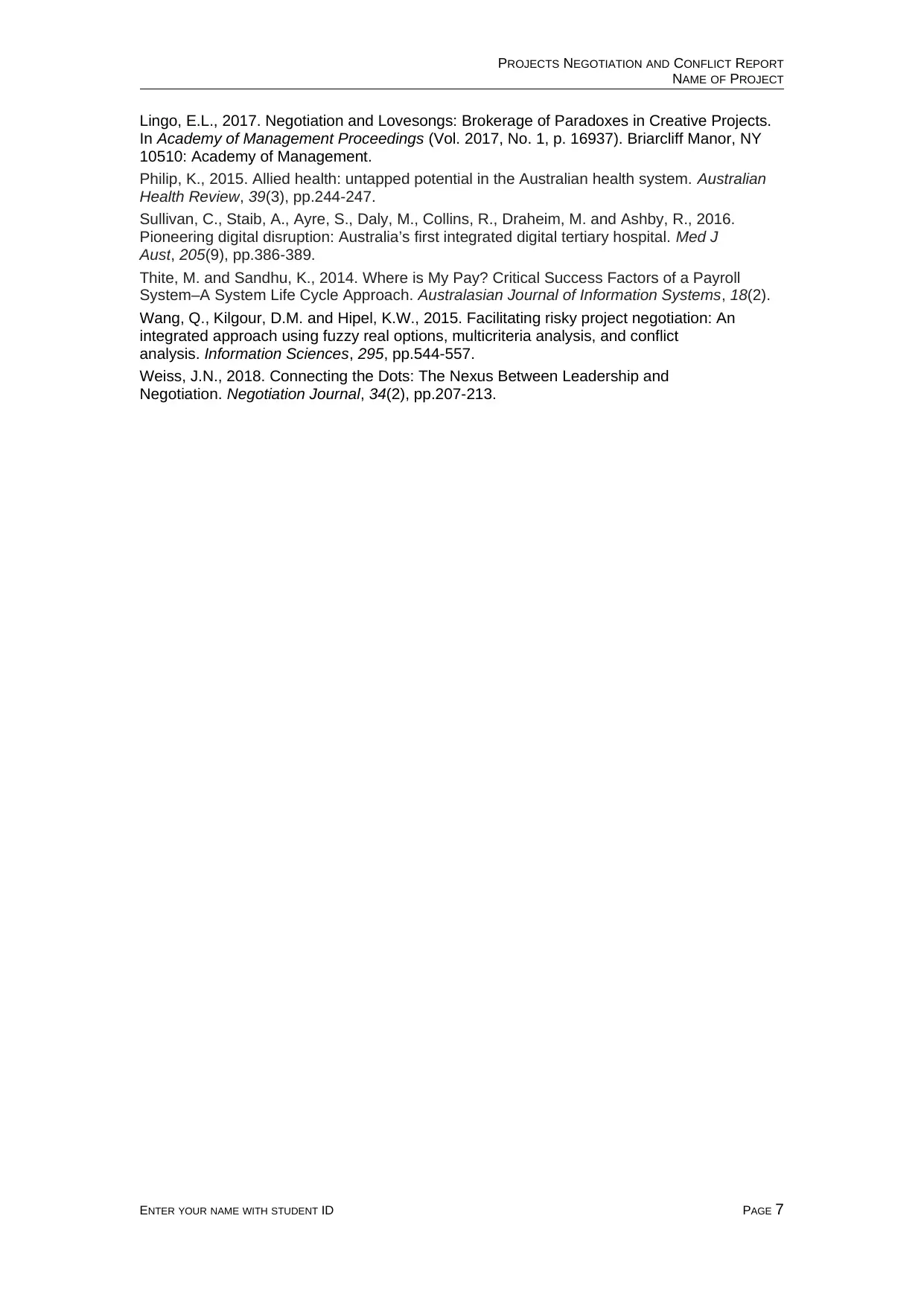
PROJECTS NEGOTIATION AND CONFLICT REPORT
NAME OF PROJECT
Lingo, E.L., 2017. Negotiation and Lovesongs: Brokerage of Paradoxes in Creative Projects.
In Academy of Management Proceedings (Vol. 2017, No. 1, p. 16937). Briarcliff Manor, NY
10510: Academy of Management.
Philip, K., 2015. Allied health: untapped potential in the Australian health system. Australian
Health Review, 39(3), pp.244-247.
Sullivan, C., Staib, A., Ayre, S., Daly, M., Collins, R., Draheim, M. and Ashby, R., 2016.
Pioneering digital disruption: Australia’s first integrated digital tertiary hospital. Med J
Aust, 205(9), pp.386-389.
Thite, M. and Sandhu, K., 2014. Where is My Pay? Critical Success Factors of a Payroll
System–A System Life Cycle Approach. Australasian Journal of Information Systems, 18(2).
Wang, Q., Kilgour, D.M. and Hipel, K.W., 2015. Facilitating risky project negotiation: An
integrated approach using fuzzy real options, multicriteria analysis, and conflict
analysis. Information Sciences, 295, pp.544-557.
Weiss, J.N., 2018. Connecting the Dots: The Nexus Between Leadership and
Negotiation. Negotiation Journal, 34(2), pp.207-213.
ENTER YOUR NAME WITH STUDENT ID PAGE 7
NAME OF PROJECT
Lingo, E.L., 2017. Negotiation and Lovesongs: Brokerage of Paradoxes in Creative Projects.
In Academy of Management Proceedings (Vol. 2017, No. 1, p. 16937). Briarcliff Manor, NY
10510: Academy of Management.
Philip, K., 2015. Allied health: untapped potential in the Australian health system. Australian
Health Review, 39(3), pp.244-247.
Sullivan, C., Staib, A., Ayre, S., Daly, M., Collins, R., Draheim, M. and Ashby, R., 2016.
Pioneering digital disruption: Australia’s first integrated digital tertiary hospital. Med J
Aust, 205(9), pp.386-389.
Thite, M. and Sandhu, K., 2014. Where is My Pay? Critical Success Factors of a Payroll
System–A System Life Cycle Approach. Australasian Journal of Information Systems, 18(2).
Wang, Q., Kilgour, D.M. and Hipel, K.W., 2015. Facilitating risky project negotiation: An
integrated approach using fuzzy real options, multicriteria analysis, and conflict
analysis. Information Sciences, 295, pp.544-557.
Weiss, J.N., 2018. Connecting the Dots: The Nexus Between Leadership and
Negotiation. Negotiation Journal, 34(2), pp.207-213.
ENTER YOUR NAME WITH STUDENT ID PAGE 7
1 out of 7
Related Documents
Your All-in-One AI-Powered Toolkit for Academic Success.
+13062052269
info@desklib.com
Available 24*7 on WhatsApp / Email
![[object Object]](/_next/static/media/star-bottom.7253800d.svg)
Unlock your academic potential
Copyright © 2020–2025 A2Z Services. All Rights Reserved. Developed and managed by ZUCOL.
